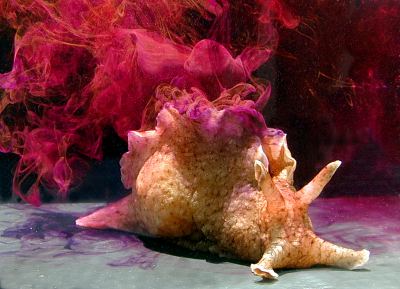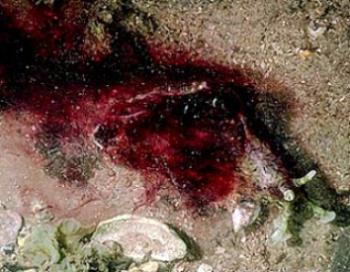

Ink glands
PHOTO
UPPER: Aplysia californica 'inking'. Coal Oil Point, Santa Barbara, California. Photo: Genevieve Anderson
LOWER: Aplysia dactylomela, releasing ink from its mantle cavity after being disturbed in a rock pool. (Long Reef, Sydney, New South Wales, 21 December 1995). Photo: Bill Rudman.
Genny Anderson's spectacular photo here of Aplysia californica producing clouds of reddish purple 'ink' illustrates one of the most common features of most Sea Hares. The commonly believed function of this ink is that, like the octopus, it provides a screen or decoy so that the Sea Hare can quickly escape when attacked. Howevere, anyone with even a fleeting knowledge of live Sea Hares will realise the a 'fast escape' is not in the repertoire of these slow crawling slugs. In fact we have no idea what the purpose of this purple ink is. I lean towards the idea that it is an excretory product associated with eating red algae, and there is evidence to support that (Chapman & Fox, 1969). Sea Hares have two main secretory glands in their mantle cavity, one we call the Purple Gland lies on the roof of the cavity, above the gill. It usually produces a purple secretion but can also produce a white ink in some species. This is not to be mistaken for the white milky secretions of the Opaline Gland which lies beneath the gill on the floor of the mantle cavity. See diagram showing position of glands in Stylocheilus striatus.
There is a lot of evidence, however, to show that Sea Hares store noxious chemicals from their algal food, particularly from red algae, in their skins, and when these chemicals are secreted, they provide a powerful defence against predation. You will see from messages below that the skin secretions are very distasteful. One extreme example is found in a Western Australian species, Aplysia gigantea which has been implicated in the deaths of many dogs. A comprehensive review by Johnson & Willows (1999) has recently been published. Also see the links below for further information on the topic.
• Johnson, P.M & Willows, A.O.D, (1999) Defense in Sea Hares (Gastropoda, Opisthobranchia, Anaspidea): multiple layers of protection from egg to adult. Marine & Freshwater Behaviour & Physiology, 32: 147-180.
See also:
•Sea Hares - chemical defence References
•Sea Hares - collecting sites in Australasia
•Sea Hares - mating chains
•Sea Hares - Species List
•Sea Hares - what are they?
•Defense in Sea Hares - a review
Rudman, W.B., 2003 (March 3) Ink glands. [In] Sea Slug Forum. Australian Museum, Sydney. Available from http://www.seaslugforum.net/factsheet/seahatac
Related messages
-
Is Sea Hare ink poisonous to fish?
From: Nicole Chilson, January 15, 2007 -
How to make dye from the Sea Hare ink.
From: Ralph Bowen, August 3, 2006 -
Dolabrifera dolabrifera - Dissection diagram for ink gland?
From: Kathryn Clark, June 17, 2006 -
Aplysia californica - ink
From: Malvina Papanastasiou, March 23, 2006 -
Separating Ink Components of Aplysia dactylometa?
From: Scott Schwartz, March 6, 2006 -
Re: Inking in Aplysia
From: lorrie creach, October 24, 2005 -
Pharmacokinetic peptides in Dolabella auricularia
From: Sallie Dugan, July 29, 2004 -
Sea Hare color purple
From: Patricia, October 24, 2003 -
Allergic to Sea Hare Ink?
From: Martin Masters, August 13, 2003 -
Do frightened Aplysia secrete ink involuntarily?
From: Dr. Stephen Hoskins, September 24, 2002 -
Re: Inking in Aplysia
From: Edwin Cruz-Rivera, June 27, 2002 -
Re: Inking in Aplysia
From: Dr.Stephen R Hoskins, June 26, 2002 -
Re: Effect of secretions on Aplysia
From: Cathryn Clarke, June 26, 2002 -
Effect of secretions on Aplysia
From: Stephen Hoskins, June 22, 2002 -
Ink Glands in Octopus and Sea Hares
From: Nadine Schoene, March 21, 2002 -
Sea Hares and Inking
From: Melanie, March 22, 2001 -
Sea Hare Self Defense
From: Tina Paget, February 21, 2001 -
Siphon Withdrawal Reflex in Sea Hares
From: Steve Potts, December 15, 2000 -
Tyrian Purple
From: Mary Townsend, August 28, 2000 -
Turtles eating Sea Hares
From: Michael D. Miller, May 5, 2000 -
What Preys on Sea Hares?
From: Claire, March 7, 2000 -
Slugs that squirt ink
From: Orso Angulo Campillo, November 25, 1999 -
A new review of Sea Hare defence mechanisms
From: Bill Rudman., August 14, 1999 -
Re: Opaline Gland
From: Assaf Zvuloni , June 28, 1999 -
Re: Sea Hares - attack and defence
From: Assaf Zvuloni, June 23, 1999 -
Sea Hares - chemical defence
From: Tom Nolen, February 22, 1999 -
palatability of sea hares: personal experience
From: Patrick Krug, Ph.D., September 9, 1998 -
Re: Sea Hares - attack & defence
From: Conxita Avila, May 19, 1998 -
Re: Sea Hares - attack & defence
From: P.M. Johnson, April 21, 1998 -
Sea Hares - attack & defence
From: P.M. Johnson, April 17, 1998
